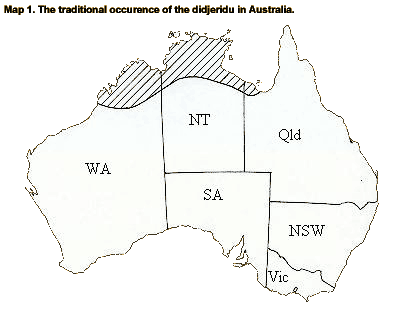|
Traditional
Didjeridu and Music of the Top End, Northern Territory
"From
1927 on I had seen corroborees, with their singing and dancing,.....,but
it was not until I made a survey in 1946 almost around Arnhem
Land that I realized the vitality and richness of the singing
and dancing of that region. I therefore determined to make
permanent records as soon as possible, so that musicians and
dancers would be able to hear and see this part of Aboriginal
culture, even if only at second hand."
Prof.
AP Elkin, (1979, p.285)
These
pages are intended as an introduction to the traditional music,
and in particular the use of the didjeridu in traditional music
within the Top End of the NT. It is by no means a definitive
work, nor is it intended to be. Rather, the reasoning behind
its development lies in the perceived need for this type of
material in this format. With the increasing interest in the
use of the didjeridu worldwide, this author believes it's important
for us to understand both the origins of this instrument and
the context in which it was and is used today by traditional
people of the region.
The
music of the Top End is rich and complex, and as Elkin said,
it's not until you take the time to listen that you realise
the depth and vitality of it.
The didjeridu,
as recently as 100 years ago, had a restricted distribution
in Australia. Map 1. is based upon the work of Dr Alice Moyle
whom researched traditional sound instruments throughout Australia,
in particular during the 1960's and '70's. The hatched area
denotes the area in which the didjeridu was a part of traditional
music during the 1960's and '70's. This includes the adjacent
islands of the Northern Territory such as Groote Eylandt and
the Wessel group and Crocodile Islands, with the exception
of the two large islands immediately north of Darwin, Bathurst
and Melville Island (Tiwi). The didjeridu is not a part of
the Tiwi peoples' musical reportoire (in fact, the Tiwi are
culturally distinct from mainland people).
Earlier researchers,
such as Elkin (1938)
noted that it was "only known in Eastern Kimberley and
the northern third of the Northern Territory". Although
now played around the globe, traditional playing style and
technique is still confined to this region.

Early this century
the instrument spread both south and east, primarily with
the movement of Aboriginal people to mission settlements and
has been incorporated into traditional music in varying degrees.
This is particularly the case for the Cape York region of
northern Queensland, although the actual playing techniques
employed are different from those used within the traditional
area. According to Berndt
(1964), "in 1945, from Wave Hill to Birrundudu and Gordon
Downs in the east Kimberleys, only young men played it; older
men regarded it as new-fangled and would have nothing to do
with it. At Balgo in 1958 it was used rarely; but two years
later it was very popular indeed.".
Garde
(1997) noted the use of the didjeridu at Aurukun (western
Cape York) in 1985, brought there by people from Doomadgee
(Gulf of Carpentaria) whom had moved there as a result of
marriage. The didjeridu was introduced to Mornington Island
in the 1930's and '40's by Larry Lanley and Larry Gavenor,
whom were born and raised there from mainland parents (Nancarrow
pers. comm.1999). It is sometimes used in traditional
music there.
Acknowledgements
|

